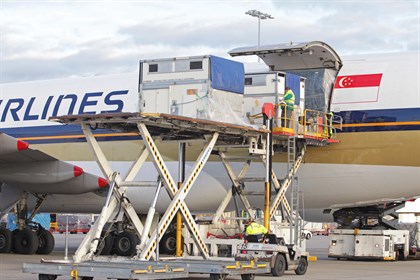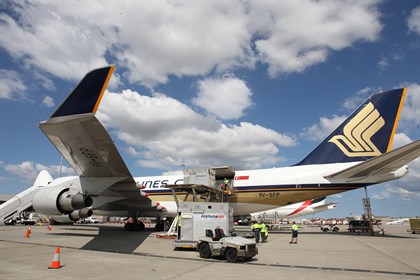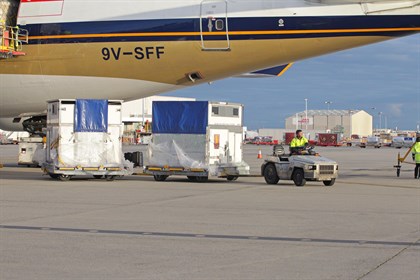
This article has appeared previously with Equestrian Life. To see what is in our latest issue, please click here.
Air stables being loaded onto a plane.
It is Spring Carnival time in Melbourne and Sydney and every week we hear of another shipment of international equine stars arriving Down Under to contest our richest feature races. But what goes on behind the scenes when horses travel?
WORDS BY UTE RAABE // PHOTOS BY IRT & RACING VICTORIA
IF HORSES WERE eligible for frequent yer loyalty programs, some of them would have racked up enough bonus miles to last them a lifetime. They are not referred to as “shuttle stallions” for nothing. The top class earners on the Darley and Coolmoore stud roster, for example, y at least twice a year to cover the breeding seasons in the northern and southern hemispheres. Then there are the elite sport horses, who spend half their career on a truck or a plane to jet from one show to another, Global Champions Tour in Miami one week, Nations Cup in Barcelona the next!
But who is organising the paperwork and travel arrangements behind the scenes? It is companies like IRT that act as the “Flight Centre” for equines and provide a door-to- door logistic service whilst meeting all the requirements set out by governments, owners and the horses themselves. IRT alone ships more than 6,000 horse per year and has about 70 employees – including office personnel, flying staff, ground crew and quarantine people – working from dedicated offices in five countries. Company founder Quentin Wallace has been working in the industry for 43 years, and his assistant Lyn for 42. Business partner Chris Burke has been with the company for 19 years. Together they know a thing or two about horse transport.
Horses being unloaded in their air stables.
For a horse to travel between any two countries, there have to be agreed protocols. Once the governments’ agricultural departments have decided on the terms of trade and health concerns, a train of rules is set in motion, which becomes a road map for horse owners, dealers, vets and transport companies. It is vital to adhere to these rules to not upset the health of the horse travelling as well as the health of the horses in the country of destination. Chris explains: “For example, if we are sending a horse from Europe to Australia, the Australian government has negotiated with countries like England, Holland or Germany a set of requirements. It is our job to look at those requirements and work out a way in which they can practically be implemented – in the real world, with a real animal!”
Quite often, what is there on paper is good as a guideline, but working around some of the logistical challenges is a skill in itself. The government authorities that create the paperwork are not the same people working in the eld. Chris has an example. “You might be asked to do a blood test within five days of travel, but that blood test might only be available at one particular lab, which will take a few days to courier to and then the test itself takes a few days to process, so you won’t have the results back in time. Things like that.” It means that IRT staff have to be quite government-savvy as well, dealing with the paperwork and processes. Chris laughs: “We have a saying in our office, “If the weight of the paperwork equals the weight of the horse, it’s ready to go”.
Air stables being moved on the tarmac.
He spends a great deal of this time on committees for export and import, is an advisor to the Australian government and travels to overseas conferences to meet leading equine and agricultural department vets to discuss the implementations of import and export protocols and how they can be better matched to reality. He stresses the importance of a cooperative partnership with these agricultural departments. “It is is in the best interests of everybody that these protocols are adhered to and that they do work and are safe. A horse bringing a disease to a country would have terrible implications. People often say, ‘well you’re the shipping agent, so you’re keen to push the boundaries’.
But I have more to lose than anybody. If the trading of horses stops, then we can’t continue, this is all we do. We have to mitigate the risk for our clients,” Chris says. “If someone is to purchase a horse in Europe, the first thing we do is give them some instructions on pre- testing and vaccinations that are required to meet the Australian conditions. The pre-test is not the test that will certify the horse for travel, but it is a screening test to ensure that the client is not buying a horse that will not qualify to enter quarantine for Australia.” The vaccinations vary depending on which country a horse is travelling to. A European horse destined for Australia needs to be vaccinated for equine influenza, whereas a North American horse would need vaccinations for eastern and western encephalitis, equine influenza and others. The risks are assessed differently for each country and the process can change over time. Since the glanders outbreak in Germany, horses are tested for glanders there when previously they weren’t. In Australia a lot of lessons were learned with the equine influenza outbreak in 2007 in terms of what testing and vaccinations should be done prior to departure. For example, a shuttle stallion that is going back to Europe for the northern breeding season will have to undergo a 30-day quarantine period; that means any horse that comes into contact with the stallion during this time will have to be tested and certified. If a stallion covers 20 or 30 mares in that period, all of them are tested and certified – a time-consuming process! Once the screening test and vaccinations have been completed, the horse enters quarantine. The quarantine station has to be approved by the Australian government, and Australian government staff have to have been able to inspect the facilities. IRT staff and accredited vets are there to manage the export testing process during quarantine, administer further vaccinations, worming, drenches – whatever is required to meet the Australian import conditions.
A horse arriving.
Currently Australia’s only quarantine facility is at Eastern Creek, near Sydney. However, a brand-new facility will open on 1 December (2015) in Melbourne (this quarantine station is now open and fully operational). The so called super-station will be in Donnybrook Rd, Mickleham, on the Hume Highway. Eastern Creek will formally close at the end of the November (2015) for all agricultural products, including horses. The new super-station will improve the bio-security risk once again due to the substantially newer facilities – including better swipe-in, swipe-out access and showers with mandated shower times – all things that come with advanced technology. With the knowledge of exotic diseases that we have today, this expertise can be incorporated in building new quarantine stations. Once the horse has completed the mandatory time and vaccinations in quarantine and has been cleared for travel, the journey to the airport begins. There are the regular passengers, like the valuable shuttle stallions and the top sport horses, and then there are your “bread and butter” horses?that may only travel once in their lifetime. However, while their price tag might differ significantly, there’s not much difference in how they travel.
“If the weight of the paperwork equals the weight of the horse, it’s ready to go”.
“When we flew Black Caviar to the UK for her Royal Ascot assignment, I was asked what we would do different, and the answer is, nothing really,” Chris confirms. “The only difference with the shuttle stallions or expensive racehorses is that they get the luxury of more space. Because of the value of the horse, owners are often in a better position to afford a bit more space in the air stable.”
A custom-built air stable allows for up to three standard-size horses of 15 or 16 hands. A breeding stallion would only have to share with one other four-legged traveller or maybe even have the whole stable to himself. Some horses travel better with company; the decision is made based on what the owner of the horse recommends and what works best. Some stallions, because of their value and their temperament, simply travel better on their own. IRT tries to avoid having mares on any breeding stallion flight, but if it does happen, the stallions would be at the front of the plane and the mares loaded some 25-30 metres further back.
What happens when a major operation like Coolmore wants to travel 12 Thoroughbred stallions? “We often divert an aircraft just for them,” Chris says, “but sometimes they share the plane with other horses. But again we would discuss with Coolmore how they wish to load their horses, one per stall or two. But that’s the only difference. We still have the vet and the same crew on board, and the testing is the same. From my point of view it is important that we as a company have the best practices in place, regardless of whether it’s a miniature pony or the world’s most valuable shuttle stallion. It’s the process that we put in place that minimises the risk to any animal traveling in the world.”
He adds: “Some of our staff literally spend their life flying around the world with horses.” Some of the four-legged passengers rack up more miles than any person in their lifetime. But what about the first-timers? The handlers need to be very mindful of the horses’ water intake during the flight. Nervous horses are unlikely to feed on their hay or drink enough water, and in this case, molasses or a boost paste is given to encourage the horse to drink. Upon arrival at the destination, the vet team can be notified and if needed, more fluid can be administered.
A horse arrives at quarantine.
Sometimes horses are prone to scramble when they get into a tight spot or there is turbulence during the flight and injure themselves. This can be solved by providing more space in the air stable. “It is important that we know if a horse has a tendency to kick or scramble on the float or truck, so we can make arrangements,” Chris says. It is very rare that horses are sedated for travel. Vet and staff have to also take into account that the horse may race or compete the next day and the drug could still be in their system. On occasion, however, it may help to sedate a nervous flyer.
“Fortunately, though, you are dealing with an intelligent animal,” Chris says, “and a horse that travels, such as an elite sport horse or racehorse, is usually a well-educated horse. Therefore you normally don’t have huge problems – but horses being horses, you never know.”
Other concerns are colic and travel sickness. Anyone who suffers motion sickness will agree, travel sickness is the biggest enemy to long-distance travel. Staff try and get the horses’ heads down to feed off the floor whenever the crew confirms there is no turbulence or when the plane is on the ground for a tech stop or refuelling. It gives horses a chance to stretch their necks and clear their throats, so to speak. During the refuelling stop all horses stay on board. If there was a technical problem with an aircraft, horses would still remain in their air stable and just change planes.
A Boeing 747 can take up to 87 horses, but usually with competition horses or racehorses there are only two horses in each air stable and therefore only 50-60 horses aboard a full charter. And then there’s American Triple Crown winner, American Pharaoh, who has his own private plane. Chris smiles: “There’s always the odd horse that has his own charter!” American Pharaoh’s plane is different; there are no air boxes, the entire inside of the Boeing 727 was gutted and replaced with stable stalls and the whole thing looks more like an open barn, complete with straw on the floor. It is what you call a walk-on, walk-off system. Chris explains the difference. “It is what was used many years ago, but obviously with airport security and also concerns about horses walking up a ramp at the airport, it doesn’t happen much any more around the world. But it is certainly a good service in the US for the domestic movement of horses.”
Following the flight, arrangements are made for the horses to be cleared at the airport and customs before they are transferred to trucks and taken to another designated quarantine station for a minimum 14 days. During that time further testing will be done, for example, for equine influenza. The horse’s health and temperature are monitored to make sure they are not developing something previously untested. IRT staff will care for the horses during this time. The period after travel is the most crucial one. Horses can appear fine hours after the flight, but it may take up to four days until you know if there’s any negativity from the travelling.
Nowadays equestrian is a global sport, the Thoroughbred breeding industry is a multi-million dollar business and there’s at least one horse in transit for every hour of the day! Almost two decades ago Chris Burke started off in the charter industry supplying clients like IRT with suitable aircraft before he eventually joined the company to share his expertise with the then mainly horsey staff. By now he is a horse expert as well!
READ THE LATEST NEWS ARTICLES HERE
https://www.equestrianlife.com.au/articles/Frequent-Flyers




